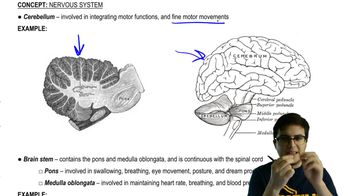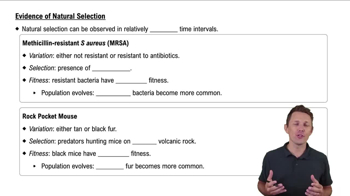Steroid hormones, like most lipid-soluble signaling molecules, are processed directly. How does the absence of a signal transduction cascade in the processing of steroid hormones affect (a) signal amplification?
Table of contents
- 1. Introduction to Biology2h 42m
- 2. Chemistry3h 40m
- 3. Water1h 26m
- 4. Biomolecules2h 23m
- 5. Cell Components2h 26m
- 6. The Membrane2h 31m
- 7. Energy and Metabolism2h 0m
- 8. Respiration2h 40m
- 9. Photosynthesis2h 49m
- 10. Cell Signaling59m
- 11. Cell Division2h 47m
- 12. Meiosis2h 0m
- 13. Mendelian Genetics4h 44m
- Introduction to Mendel's Experiments7m
- Genotype vs. Phenotype17m
- Punnett Squares13m
- Mendel's Experiments26m
- Mendel's Laws18m
- Monohybrid Crosses19m
- Test Crosses14m
- Dihybrid Crosses20m
- Punnett Square Probability26m
- Incomplete Dominance vs. Codominance20m
- Epistasis7m
- Non-Mendelian Genetics12m
- Pedigrees6m
- Autosomal Inheritance21m
- Sex-Linked Inheritance43m
- X-Inactivation9m
- 14. DNA Synthesis2h 27m
- 15. Gene Expression3h 20m
- 16. Regulation of Expression3h 31m
- Introduction to Regulation of Gene Expression13m
- Prokaryotic Gene Regulation via Operons27m
- The Lac Operon21m
- Glucose's Impact on Lac Operon25m
- The Trp Operon20m
- Review of the Lac Operon & Trp Operon11m
- Introduction to Eukaryotic Gene Regulation9m
- Eukaryotic Chromatin Modifications16m
- Eukaryotic Transcriptional Control22m
- Eukaryotic Post-Transcriptional Regulation28m
- Eukaryotic Post-Translational Regulation13m
- 17. Viruses37m
- 18. Biotechnology2h 58m
- 19. Genomics17m
- 20. Development1h 5m
- 21. Evolution3h 1m
- 22. Evolution of Populations3h 53m
- 23. Speciation1h 37m
- 24. History of Life on Earth2h 6m
- 25. Phylogeny2h 31m
- 26. Prokaryotes4h 59m
- 27. Protists1h 12m
- 28. Plants1h 22m
- 29. Fungi36m
- 30. Overview of Animals34m
- 31. Invertebrates1h 2m
- 32. Vertebrates50m
- 33. Plant Anatomy1h 3m
- 34. Vascular Plant Transport1h 2m
- 35. Soil37m
- 36. Plant Reproduction47m
- 37. Plant Sensation and Response1h 9m
- 38. Animal Form and Function1h 19m
- 39. Digestive System1h 10m
- 40. Circulatory System1h 49m
- 41. Immune System1h 12m
- 42. Osmoregulation and Excretion50m
- 43. Endocrine System1h 4m
- 44. Animal Reproduction1h 2m
- 45. Nervous System1h 55m
- 46. Sensory Systems46m
- 47. Muscle Systems23m
- 48. Ecology3h 11m
- Introduction to Ecology20m
- Biogeography14m
- Earth's Climate Patterns50m
- Introduction to Terrestrial Biomes10m
- Terrestrial Biomes: Near Equator13m
- Terrestrial Biomes: Temperate Regions10m
- Terrestrial Biomes: Northern Regions15m
- Introduction to Aquatic Biomes27m
- Freshwater Aquatic Biomes14m
- Marine Aquatic Biomes13m
- 49. Animal Behavior28m
- 50. Population Ecology3h 41m
- Introduction to Population Ecology28m
- Population Sampling Methods23m
- Life History12m
- Population Demography17m
- Factors Limiting Population Growth14m
- Introduction to Population Growth Models22m
- Linear Population Growth6m
- Exponential Population Growth29m
- Logistic Population Growth32m
- r/K Selection10m
- The Human Population22m
- 51. Community Ecology2h 46m
- Introduction to Community Ecology2m
- Introduction to Community Interactions9m
- Community Interactions: Competition (-/-)38m
- Community Interactions: Exploitation (+/-)23m
- Community Interactions: Mutualism (+/+) & Commensalism (+/0)9m
- Community Structure35m
- Community Dynamics26m
- Geographic Impact on Communities21m
- 52. Ecosystems2h 36m
- 53. Conservation Biology24m
28. Plants
Nonvascular Plants
Problem 13
Textbook Question
<Image>
Moss sperm are motile and capable of swimming short distances to fertilize an egg. However, it was unknown until recently how sperm make their way from male to female gametophytes that may be separated by a distance of several centimeters or more.
Beyond the results presented here, what other evidence would be useful when drawing conclusions about the role of springtails in moss reproduction?
 Verified step by step guidance
Verified step by step guidance1
Consider the ecological interactions between mosses and springtails. Investigate whether springtails are commonly found in environments where mosses grow, and if their presence correlates with successful moss reproduction.
Examine the physical characteristics of springtails that might facilitate the transport of moss sperm. For example, study their movement patterns and body structures to determine if they can carry or transfer sperm effectively.
Conduct experiments to observe the behavior of springtails in the presence of moss sperm. Determine if springtails are attracted to moss sperm or if they exhibit behaviors that suggest they are involved in sperm transport.
Analyze the genetic material of mosses in areas with and without springtails to see if there is a difference in genetic diversity or reproductive success, which could indicate the role of springtails in facilitating cross-fertilization.
Investigate the chemical signals or cues that might be involved in attracting springtails to moss sperm. Identify any pheromones or other chemical attractants that could play a role in this interaction.
 Verified video answer for a similar problem:
Verified video answer for a similar problem:This video solution was recommended by our tutors as helpful for the problem above
Video duration:
41sPlay a video:
Was this helpful?
Key Concepts
Here are the essential concepts you must grasp in order to answer the question correctly.
Moss Reproduction
Mosses reproduce sexually through the production of gametes: sperm and eggs. The sperm are motile and swim to reach the egg for fertilization. This process typically occurs in moist environments, which facilitate sperm movement, highlighting the importance of water in moss reproduction.
Recommended video:
Guided course

Fungi Reproduction - 3
Role of Springtails
Springtails are small, soil-dwelling arthropods that may play a role in moss reproduction by aiding in the transport of sperm between gametophytes. Understanding their behavior and interactions with mosses can provide insights into their potential role as facilitators in the reproductive process, especially over distances where direct sperm swimming is insufficient.
Recommended video:
Guided course

Cerebellum and Brainstem
Evidence in Biological Research
In biological research, evidence is crucial for drawing conclusions about ecological interactions. Useful evidence could include observational studies of springtail behavior, experiments demonstrating sperm transport by springtails, and genetic analyses showing successful fertilization facilitated by these organisms. Such evidence helps clarify the mechanisms of moss reproduction involving springtails.
Recommended video:

Evidence of Natural Selection

 6:16m
6:16mWatch next
Master Nonvascular Plants - 1 with a bite sized video explanation from Jason
Start learningRelated Videos
Related Practice
Textbook Question
1043
views
